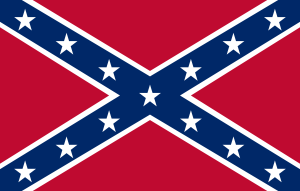Civil War: Difference between revisions
(Ins Rebel flag pic.) |
(cat) |
||
| Line 6: | Line 6: | ||
[[Image:Confederate Rebel Flag.png|thumb|The "Rebel flag," adapted from a Confederate battle flag.]]As African Americans campaigned for equal civil rights in the 1960s, segregationists appropriated symbols of the Confederacy, such as the so-called "Rebel flag," to symbolize their determination to preserve white supremacy in the South. As a result, the display of the flag continues to be controversial to this day. Defenders of the flag maintain that it is intended as a symbol of southern regional pride, not of racial antagonism. | [[Image:Confederate Rebel Flag.png|thumb|The "Rebel flag," adapted from a Confederate battle flag.]]As African Americans campaigned for equal civil rights in the 1960s, segregationists appropriated symbols of the Confederacy, such as the so-called "Rebel flag," to symbolize their determination to preserve white supremacy in the South. As a result, the display of the flag continues to be controversial to this day. Defenders of the flag maintain that it is intended as a symbol of southern regional pride, not of racial antagonism. | ||
[[Category:Civil War]] | |||
Revision as of 12:33, 26 August 2010
The American Civil War (1861-1865) was the war that followed the secession of eleven southern states, including Alabama, from the United States of America. The southern states proclaimed their independence as the Confederate States of America, or Confederacy. Over the next four years the United States, or Union, defeated the Confederates, abolished slavery, and gradually reincorporated the southern states through a process called Reconstruction. The war claimed more than 620,000 lives, and was by far the most destructive war ever fought on American soil.
At the time of the war, Birmingham had not yet been founded, and Jones Valley was still thinly settled. The Birmingham District includes a few sites where iron was manufactured in the 1860s to supply the Confederate war effort, but the most significant war manufacturing center in Alabama was at Selma. The state capital, Montgomery, served briefly as the Confederate capital, and Confederate president Jefferson Davis was inaugurated there in February 1861. The most significant military campaign in the Birmingham District was Wilson's Raid, in which a Union cavalry corps destroyed Confederate manufacturing sites during the final month of the war.
Confederate veterans played significant roles in Birmingham's early history. Memories of the war, and competing interpretations of its meaning, have shaped events in the city and state ever since, often serving to divide black and white citizens. The Daughters of the Confederacy, an organization for white southern women, took the lead in establishing monuments to the "Lost Cause" and in directing schools to teach white southern children an approved version of the history of the "War Between the States."
As African Americans campaigned for equal civil rights in the 1960s, segregationists appropriated symbols of the Confederacy, such as the so-called "Rebel flag," to symbolize their determination to preserve white supremacy in the South. As a result, the display of the flag continues to be controversial to this day. Defenders of the flag maintain that it is intended as a symbol of southern regional pride, not of racial antagonism.
